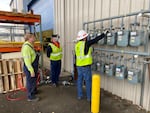Dan Serres with the environmental group Columbia Riverkeeper drove to Hermiston on his birthday last month to investigate — and try to stop — a controversial natural gas plant project that has yet to be built.
He stood on his car alongside the highway to take photos without trespassing at the proposed development site for the Perennial Wind Chaser plant.
“I’m looking at an illegal road that was built in violation of the Clean Water Act,” he said. “The hum here in the background is the Hermiston Generating Plant which is next door, and it’s currently one of the top polluters in the state for carbon pollution.”

A dirt road at the development site for the Perennial Wind Chaser natural gas power plant, next to the Hermiston Generating Plant in Eastern Oregon.
Dan Serres
For Serres, building a new natural gas plant is the opposite of what Oregon should be doing to reduce the greenhouse gas emissions that contribute to climate change.
Now that the state’s last coal-fired power plant is gone, and Oregon is cutting ties with coal-fired power elsewhere, environmentalists are shifting their focus to natural gas. It’s the state’s second-largest source of greenhouse gas emissions after transportation fuels if you add up its use for electricity, manufacturing and home heating and cooking.
“And that’s only the emissions you see from burning the burning of gas,” Serres said, noting that the state doesn’t tally the methane gas that leaks out of pipelines or is lost during the drilling process — known as hydraulic fracturing, or fracking — to extract the gas from underground. “Most of our gas comes from fracking, and we know it’s a tremendous impact on the climate.”
Columbia Riverkeeper sued the state for allowing the Perennial project to continue in violation of state and federal rules. Serres said the project poses a huge threat to Oregon’s climate goals, which aim to reduce greenhouse gas emissions to 80% below 1990 levels by 2050.
“What we need to be thinking about is how we electrify our systems and get away from the use of fossil gas altogether,” Serres said.
Stopping new natural gas power plants is only part of the battle plan for environmental groups. They’re also fighting to ban natural gas in homes and commercial buildings. Several major cities in California have passed mandates for new construction to be all-electric, without natural gas lines. Washington Governor Jay Inslee has proposed a similar rule for carbon-free buildings statewide in the Healthy Homes and Clean Buildings Act.
Electrify everything?
The abundance of gas-burning stoves in the Basco Appliances showroom in Northwest Portland suggests the movement away from natural gas in home heating and cooking still has a long way to go. Its 17 live kitchens showcase just a few all-electric models.
Store manager Fred Graetzer said 95% of the stoves he sells use natural gas because people like how quickly it heats up.
“Turn on the gas, it’s instant,” he said. “Put it up 20,000 BTUs — boom. It’s there. That’s the real love.”

Basco Appliances General Manager Fred Graetzer lights the burner on a gas stove in the store's Northwest Portland showroom.
Cassandra Profita / OPB
The store does sell induction stoves, which run on electricity and also heat up instantly using an electromagnetic field to generate heat. But Graetzer said he’s not selling many of those because people don’t know much about them.
Matt Vespa is an attorney for EarthJustice, an environmental group that’s making the case for more all-electric buildings — including stoves. He notes natural gas releases harmful pollutants when it’s burned in stoves and furnaces and cites research showing exposure to those pollutants can increase the risk of childhood asthma.
“This is not just a climate issue. It’s a public health issue and an air pollution issue,” he said. ”There are serious health impacts from this. I think it’s going to be looked back at like, ‘Why were we smoking cigarettes at home?’”
David Farrer, a toxicologist with Oregon Health Authority, said proper ventilation reduces the health risks of pollutants like nitrogen oxide, carbon monoxide, formaldehyde and volatile organic compounds that are released from burning natural gas, and everyone should have a carbon monoxide detector in the house and use a ventilating fan while cooking.
“Natural gas is cleaner than most other fuels, but it’s not perfect,” he said. “There are still emissions from it. Cooking produces pollutants into the air even if you’re using an electric range, so there’s more when you’re using natural gas but it’s not zero if you’re just cooking with an electric range.”
Vespa argues electric heat pumps for home heating and induction stoves for cooking are more efficient than their gas alternatives, and they get cleaner as utilities add more renewable wind and solar power to the grid.
“I think you get a lot when you go electric,” he said. “Everyone deserves a healthy home, and frankly gas homes are not healthy. We need to basically electrify everything we can.”
Decarbonize the gas?
Vespa’s vision of an all-electric future poses an existential threat to utilities that depend on selling natural gas.
NW Natural, a gas utility that serves more than 700,000 customers across the region, isn’t taking that threat lying down.
Kim Heiting, senior vice president of operations at NW Natural, said there’s another way to cut carbon emissions from natural gas — by phasing in renewable alternatives collected from wastewater treatment plants, dairy farms, wood and food waste.
Beyond that, Heiting said, the company can use green hydrogen made from water that can also substitute for natural gas.
“We deliver energy through pipes,” she said. “What goes through those pipes can and will change ... And that’s really our vision for decarbonization.”
The company has an elaborate plan for decarbonizing all of its gas by 2050. It has three biogas projects in Oregon scheduled to go online this year and recently announced a plan to invest $38 million in four renewable natural gas projects drawing biogas from water treatment systems at Tyson Foods processing plants.
Heiting said her company is moving quickly toward buying and selling more renewable natural gas in Oregon because of a bill lawmakers passed last year.
“No other gas utility that we know of in the country has this kind of legislation that allows them to procure renewable natural gas just as they do conventional natural gas,” she said.
Heiting also envisions a “power to gas” system that would take excess wind, solar and hydropower and use them to make green hydrogen, splitting the hydrogen molecules from oxygen molecules in water. That gas can then be stored in existing gas storage facilities so it can be used later. The company is already testing out the process of making green hydrogen at a facility in Sherwood, and it has an agreement with Eugene Water & Electric Board to explore developing a future green hydrogen production facility.

NW Natural employees Glenn Cavender, Clay Studtman and Bill Adler test blended hydrogen gas at the company's Sherwood facility.
Courtesy of NW Natural
Critics say there isn’t nearly enough renewable gas supply to replace all the natural gas we’re using, and that green hydrogen is too expensive to be viable.
“There’s not enough — not remotely enough — renewable natural gas available for the gas company to displace all of its fossil natural gas or even a significant amount,” Angus Duncan, chair of the Oregon Global Warming Commission, said. “If they could replace 10 to 20 percent it would be surprising.”
Duncan said because natural gas prices have gotten so low with more gas production, the use of natural gas in Oregon has actually gone up in recent years, and direct combustion of natural gas is up 60% since the state’s base year of 1990.
“It’s very cheap, and it has been for some years now,” he said. “That encourages people to use gas for space and water heating, and while the gas company says the right things about wanting to decarbonize it is furiously extending gas mains and hooking up new customers.”
Duncan also served as the president of the Bonneville Environmental Foundation, and he said that group has explored the idea of green hydrogen and found “a whole raft of problems.”
“It’s expensive because it’s hard to make,” he said. “It’s frankly pretty dubious that we will see hydrogen in home, space and water heating applications.”
But Heiting says energy efficiency will reduce the amount of gas people need in the future, and new policies would help decarbonize the gas system just like they did with the electric system.
“There were critics that we’re saying we can’t invest in wind and solar. It’s just way too expensive. And thankfully, we didn’t let that stop us,” she said. “Can we really get enough renewables in the pipeline? And the answer is yes, but we have to put policy in place. We need production tax credits for renewable natural gas. We need production tax credits for renewable hydrogen at the federal level, just like we put in place for wind and solar.”
At this point, it’s still unclear which vision Oregon will embrace: A future with decarbonized gas pipelines or one without any gas lines at all.



